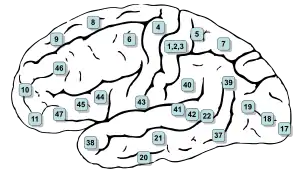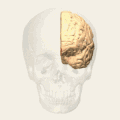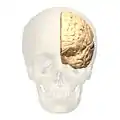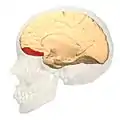| Brodmann area 12 | |
|---|---|
 Brodmann area 12(shown in orange) | |
 Image of brain with Brodmann areas numbered | |
| Identifiers | |
| NeuroNames | 77 |
| NeuroLex ID | birnlex_1743 |
| FMA | 68609 |
| Anatomical terms of neuroanatomy | |
Brodmann area 12 is a subdivision of the cerebral cortex of the guenon defined on the basis of cytoarchitecture.[1][2] It occupies the most rostral portion of the frontal lobe. Brodmann-1909 did not regard it as homologous, either topographically or cytoarchitecturally, to rostral area 12 of the human. Distinctive features (Brodmann-1905): a quite distinct internal granular layer (IV) separates slender pyramidal cells of the external pyramidal layer (III) and the internal pyramidal layer (V); the multiform layer (VI) is expanded, contains widely dispersed spindle cells and merges gradually with the underlying cortical white matter; all cells, including the pyramidal cells of the external and internal pyramidal layers are inordinately small; the internal pyramidal layer (V) also contains spindle cells in groups of two to five located close to its border with the internal granular layer (IV).
It is indirectly connected to the globus pallidus as well as the substantia nigra, due to efferents to the striatum. Glutaminergic input is turned into GABAergic input there, which allows the frontal lobes to exhibit some control over basal ganglia activity.
Image
 Animation.
Animation. Frontal view.
Frontal view. Medial view.
Medial view.
See also
References
- ↑ Kawamura, M.; Miller, M. W.; Ichikawa, H.; Ishihara, K.; Sugimoto, A. (2011-05-03). "Brodmann area 12: An historical puzzle relevant to FTLD". Neurology. 76 (18): 1596–1599. doi:10.1212/WNL.0b013e3182190cd8. ISSN 0028-3878. PMID 21536640. S2CID 207119341.
- ↑ Kawamura, Mitsuru (2017-04-01). "[The Role of Brodmann Area 12: Taste, Social Cognition, and Mental Time]". Brain and Nerve = Shinkei Kenkyu No Shinpo. 69 (4): 375–381. doi:10.11477/mf.1416200754. ISSN 1344-8129. PMID 28424392.
External links
- For Neuroanatomy of this area see BrainInfo